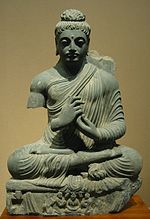Apoha (Sanskrit: अपोह) is a Buddhist epistemological theory first proposed by the philosopher Dignāga (c. 480 – c. 540 CE) in his seminal text Pramāṇasamuccaya...
13 KB (1,770 words) - 19:50, 30 September 2024
knowledge and introduced the widely influential theory of "exclusion" (apoha) to explain linguistic meaning. His work on language, inferential reasoning...
23 KB (2,840 words) - 10:58, 17 October 2024
Sanskrit, the Nyāyabinduṭīkā, while others survive in Tibetan translation. Apoha-nāma-prakaraṇa (gzhan sel ba zhes bya ba'i rab tu byed pa) Kṣaṇabhaṅgasiddhi...
2 KB (142 words) - 21:41, 16 April 2024
"moderate" nominalism. Examples of nominalists include Buddhist logicians and apoha theorists, the medieval philosophers Roscelin of Compiègne and William of...
11 KB (1,318 words) - 18:58, 30 July 2024
positive theory of nominalism, known as the apoha theory, which denies the existence of universals. The apoha theory identifies particulars through double...
40 KB (4,928 words) - 05:16, 27 September 2024
Routledge India, and Indian Institute of Advanced Study, Shimla, 2013. Apoha: Buddhist Nominalism and Human Cognition (Co-edited with Mark Siderits and...
2 KB (220 words) - 11:38, 1 April 2024
members share in common. On the contrary, universal classes are exclusions (apoha). As such, the "cow" class, for example, is composed of all exclusions common...
34 KB (4,367 words) - 20:28, 26 October 2024
structure and types of formal inference and the apoha (exclusion) theory of meaning. Dan Arnold writes that apoha is: "the idea that concepts are more precise...
11 KB (1,346 words) - 13:46, 3 April 2024
Event: dharma, chos Event-associate: dharmin, chos can Exclusion: Apoha, sel ba (Anya-apoha: gzhan sel ba) Exemplification: drstanta, dpe Inference: anumana...
57 KB (7,046 words) - 09:50, 2 November 2024
logic and epistemology (pramāṇa), especially the theory of "exclusion" (apoha) outlined by Dignaga (c. 480 – c. 540 CE) and how it relates to the philosophy...
17 KB (2,012 words) - 23:31, 18 October 2024
Center for Buddhist Translation and Research Shoryu Katsura, "The Theory of Apoha in Kuiji’s Cheng weishi lun Shuji" pp. 101–120 in: Chen-kuo Lin / Michael...
9 KB (1,146 words) - 01:06, 30 September 2024
perceptual content, Dharmakirti takes up Dignaga's theory of "exclusion" (apoha). Dignāga's view is that "a word talks about entities only as they are qualified...
27 KB (3,095 words) - 15:58, 17 October 2024
Philosophy & Literature 35 (2011): 269–281, with Panayiota Vassilopoulou. “Apoha, feature-placing, and sensory content,” in Buddhist Semantics and Human...
14 KB (1,751 words) - 21:00, 22 May 2024
borrowed and developed by Utpaladeva are the theories of anupalabdhi and apoha. Utpaladeva also draws on the linguistic metaphysics of the grammarian Bhartr̥hari...
14 KB (1,821 words) - 20:17, 28 July 2024
invariable concomitance or pervasion. To this end, a doctrine known as "apoha" or differentiation was developed. This involved what might be called inclusion...
102 KB (13,265 words) - 23:10, 16 September 2024
[2] (accessed: December 12, 2007) Katsura, Shoryu (2014). The Theory of Apoha in Kuiji’s "Cheng weishi lun Shuji" (Katsura, Shoryu). In Lin, Chen-kuo...
6 KB (617 words) - 15:04, 26 July 2024
T.J.F. (1986b). «Identity and Referential Opacity in Tibetan Buddhist apoha Theory», in B. K. Matilal et R.D. Evans (eds.), Buddhist Logic and Epistemology...
14 KB (1,879 words) - 23:48, 12 January 2023
arrays of proposition P [and its 'inseparable contradistinction' (Sanskrit: apoha)]. The eight arrays or octaves of the iconographic Dharmacakra represent...
34 KB (4,175 words) - 15:20, 12 September 2024
include: Apohasiddhi - This text focuses on the key theory of exclusion (apoha) and defends his views on it from critics Īśvarasādhanadūṣaṇa - This work...
14 KB (1,651 words) - 03:11, 13 September 2024
and all the methods of proof or refutation. According to the doctrine of apoha (gshan-sel-wa in Tibetan), an entity is defined as the negation of its opposite;...
24 KB (3,089 words) - 00:35, 26 January 2024








